A Moment in Time: President Ronald Reagan Launches Construction of Westway
By Richard F. Weingroff
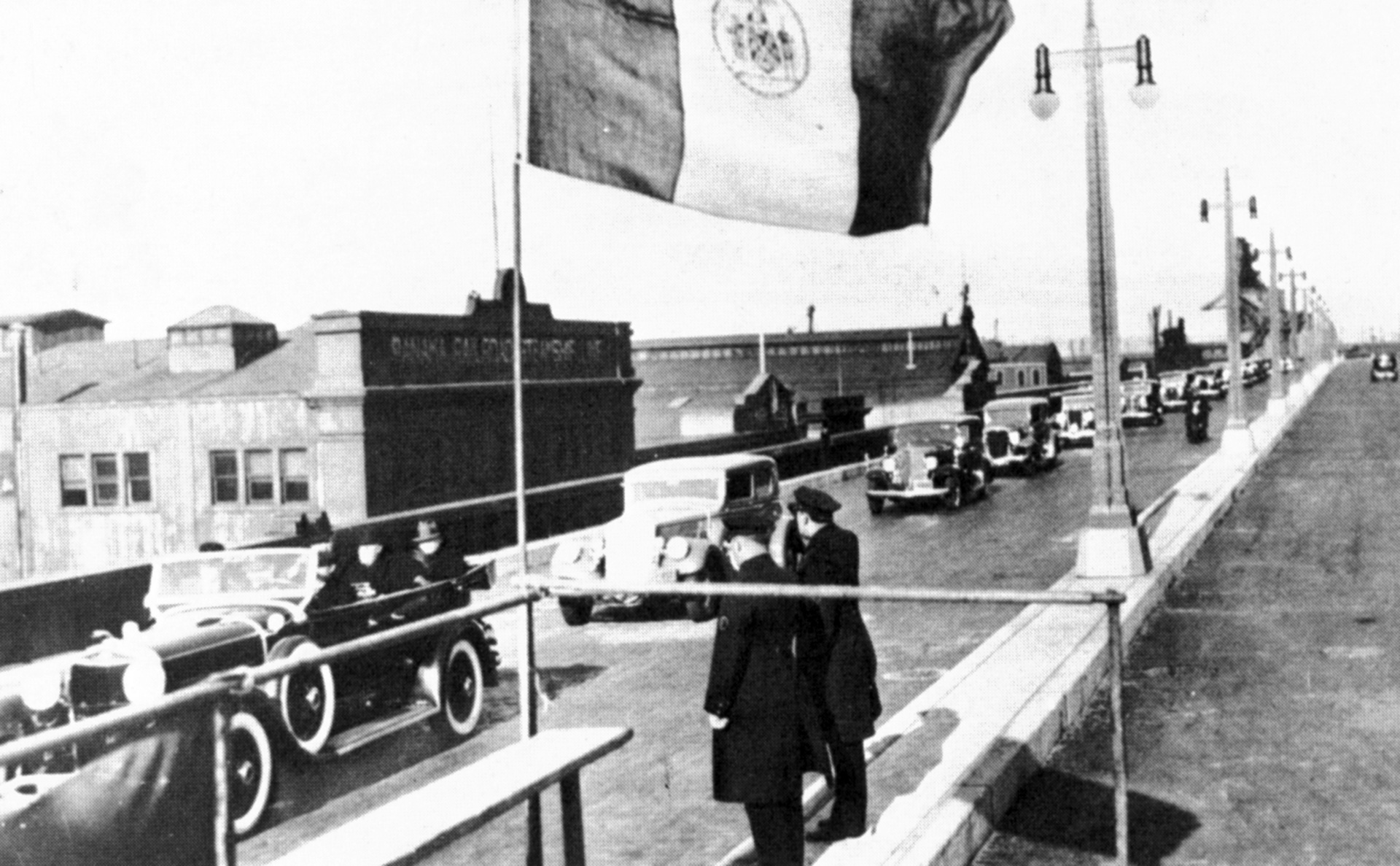
On January 5, 1933, Mayor John P. O'Brien led a motorcycle celebrating the opening of the West Side Highway, from 22nd Street to 40th Street, on January 5, 1933.
On Labor Day, September 7, 1981, President Ronald Reagan went to New York City to present a symbolic check for $85 million to the State and the city to begin the purchase of right-of-way for Westway/I-476, one of the country's most controversial urban Interstate projects.
As the President put it, "it was 10 years ago that this project was first proposed, and for 10 years nothing happened while hundreds of thousands of New Yorkers needed work." Westway had, he said, "become a code word for a bureaucracy strangling in its own regulations." That was no longer the case:
We have silenced bureaucrats, cut through the red tape and kept our promises . . . . The Westway project begins today . . . . So, as I present this check for $85 million for the purchase of the right of way, the first installment of a $1.3 billion Federal commitment, let us all take heart . . . from this victory over the inertia of bureaucracy.
The West Side Elevated Highway
Today, it's easy to forget that elevated highways once were seen as the ideal solution to congestion choking traffic in every large city. The West Side Highway along the Hudson River in New York City was one of the earliest examples and a model for other cities. Its predecessor, Eleventh Avenue, was known as "Death Avenue." In 1926, the city adopted a plan promoted by Manhattan Borough President Julius Miller for an elevated freeway from Canal Street to 129th Street that would cost $11 million. The first section (Canal to 22nd Streets) began in May 1929 and was completed in November 1930. The second section opened in March 1932. In 1931, Mayor James J. "Jimmy" Walker secured approval to name the elevated highway the "Miller Highway" in honor of Julius Miller.
The West Side Highway was built for cars, not trucks. Contrary to later practice, entrances and exits were in the center of the highway, with slow-moving traffic using the left lanes. These segments were built with sudden curves and narrow ramps to avoid buildings on either side, practices that were adequate for an era when speeds rarely exceeded 30 or 40 miles per hour.
As the Westway environmental review would state, the West Side/Miller Highway was "admirably suited to its purpose and location" during its early years. The structure allowed trucks to travel under the facility between the busy Hudson River piers to the east and the factories and warehouses to the west while cars traveled above the industrial traffic.
The Depression of the 1930s and World War II delayed development, but the highway was finally extended through a tunnel under Battery Park when the $80 million Brooklyn-Battery Tunnel (renamed the Hugh L. Carey Tunnel) opened at the southern tip of Manhattan on May 25, 1950.
Deteriorating at an Alarming Rate
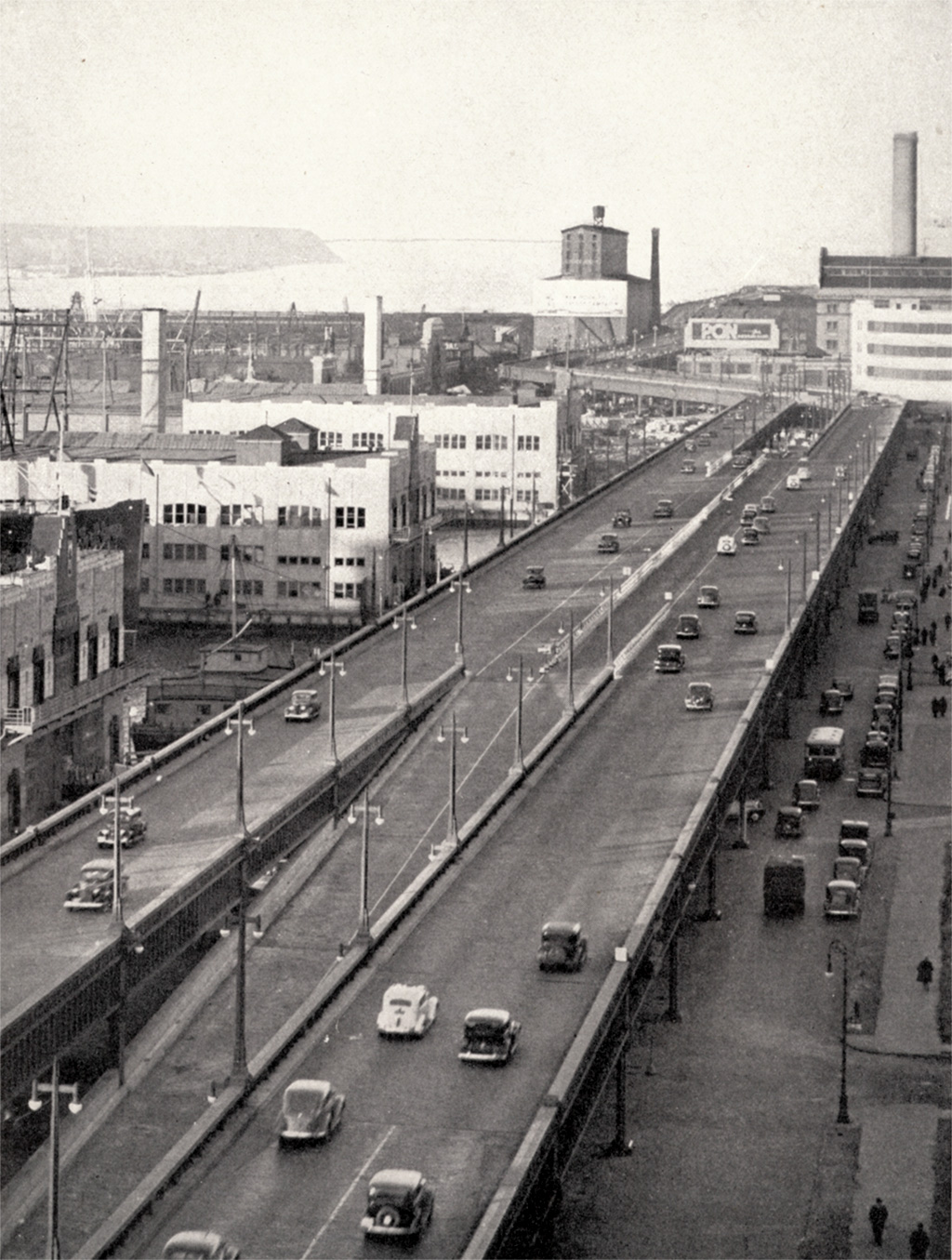
The elevated West Side Highway featured center entrances and exits.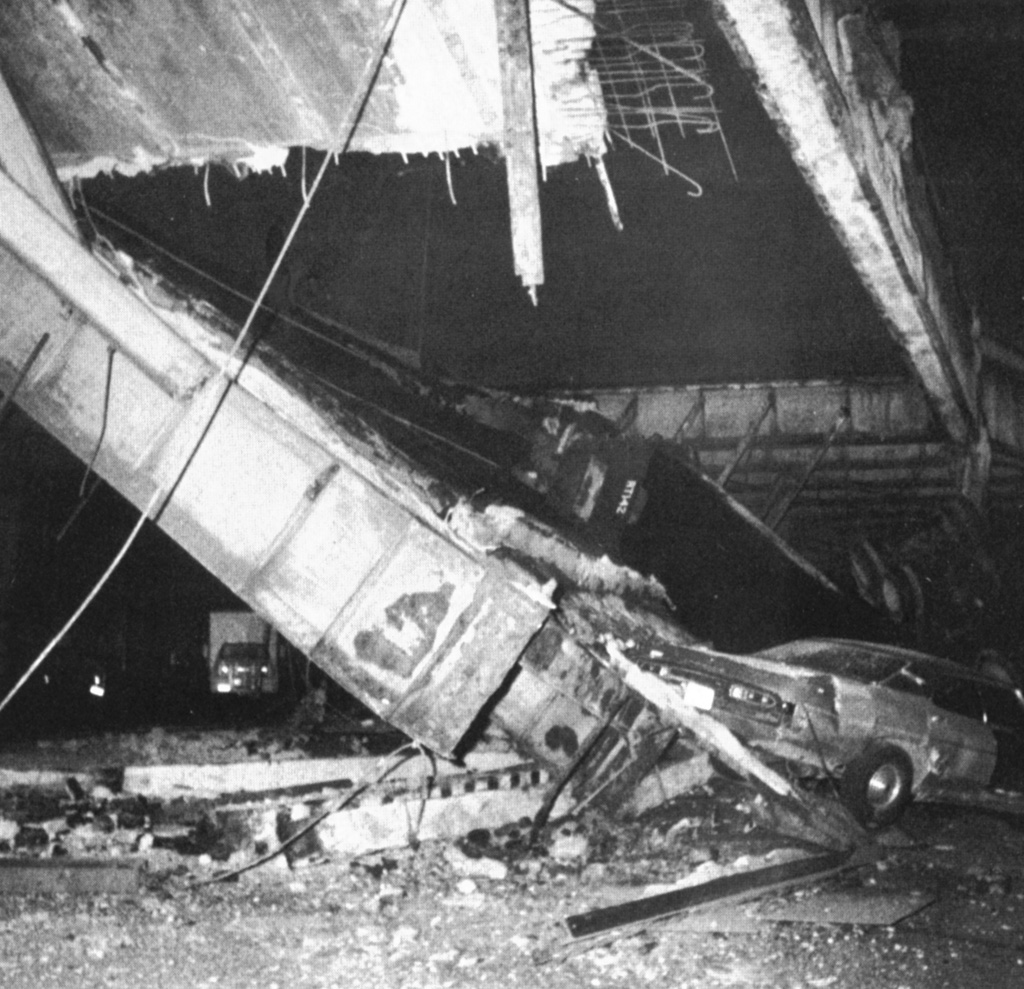
On December 15, 1973, the northbound lanes of the West Side Highway collapsed between Little West 12th Street and Gansevort Street under the weight of an overloaded dump truck carrying asphalt for repairs of the highway. Neither the driver of the truck, who jumped clear as the truck fell off the upper level, nor the driver of the four-door sedan suffered serious injuries.
As traffic and speeds increased, the Miller Highway became increasingly obsolete while a lack of sufficient maintenance allowed the structure to deteriorate. The environmental review stated. "The narrow ramps, sharp curves, left-handed entrances and exits, and a crumbling roadbed posed serious hazards." The expense of maintaining the inadequate facility was "escalating at an alarming rate."
Studies beginning in the mid-1950s resulted in a 1971 plan called Wateredge for an ambitious remake of the area. The Miller Highway would be torn down and replaced with an "outboard" double-deck highway as much as 1,200 feet from the Hudson River shore. The double-deck "outboard" facility would include concrete pilings that would stretch back to the shore bulkhead, creating more than 700 acres for housing, waterfront park, commercial development, and community facilities. As a 1984 congressional study pointed out, "This colossal concrete double-deck-over-the-water proposal apparently was designed to satisfy every conceivable concern for revitalizing the Lower West Side waterfront.
The financial plan for the project was simple: securing 90-percent Interstate funding from the Federal Highway Administration (FHWA). In a series of Interstate route deletions and additions in New York City requested by the State and city, FHWA approved the West Side Highway corridor as I-478 in November 1971.
The urgency of the situation was brought home on December 15, 1973, when the northbound lanes between Little West 12th Street and Gansevort Street collapsed under an overloaded dump truck carrying 60,000 pounds of asphalt for repairs of the highway. The city closed the West Side Highway between 46th Street and the Brooklyn-Battery Tunnel. Traffic soon overwhelmed the Hudson riverfront and virtually shut off access to Riverside Park.
Enter Lowell K. Bridwell
Soon after securing designation of I-478, Governor Nelson A. Rockefeller and New York City Mayor John V. Lindsay signed a memorandum of understanding establishing "the organizational and policy framework for a West Side Highway Project." They selected Lowell K. Bridwell, who headed System Design Concepts of Columbia, Maryland, as executive director.
Bridwell, a former journalist who had specialized in writing about highways, had joined the Department of Commerce in April 1962 as assistant to the Under Secretary for Transportation. He also served as Acting Deputy Federal Highway Administrator (January-July 1964) before becoming Deputy Under Secretary of Commerce for Transportation in July, a post that positioned him to help Under Secretary Alan S. Boyd achieve President Lyndon B. Johnson's vision for a U.S. Department of Transportation. President Johnson appointed Boyd the first Secretary of Transportation and Bridwell as Federal Highway Administrator (March 1967-January 1969).
Bridwell oversaw the environmental review of Westway under the National Environmental Policy Act (NEPA). The April 1974 draft environmental impact statement (EIS) whittled the reasonable alternatives to five, but favored an outboard landfill design. A six-lane highway and a two-lane transitway for express buses would be depressed in a 243-acre landfill along the 4.2-mile route. This alternative, the draft argued, would improve air, noise, and water quality. The draft EIS acknowledged that the Lower Hudson River was an "important" protective estuary for fish, including the striped bass (or rockfish as it is called in some regions), but impacts on the habitat would be minimal.
After considering names such as West Park and West Parkway, officials settled on a new name: Westway.
On December 19, 1974, Action for Rational Transit (ART) and 30 other organizations filed the first lawsuit to stop Westway. Plaintiffs charged that the proposal would violate Federal clean air laws and involved segmentation of the project, which they charged was only one-third of a corridor to the George Washington Bridge.
Meanwhile, the Federal-Aid Highway Act of 1973, approved on August 13 by President Richard M. Nixon, included a provision that gave cities a way out of urban freeway controversies without losing the economic boost from the incoming funds. The Governor and local governments in urbanized areas over 50,000 population could propose to withdraw the unwanted Interstate freeway and substitute an equal amount of general Treasury funds for mass transportation projects. For local members of Congress who had fought for this provision, transit advocates, and critics of urban freeways, the withdrawal/substitution provision would be an increasingly appealing substitute for I-478. (Congress later expanded the substitution option to include highway projects.)
The final EIS in January 1977 adopted a "modified outboard" landfill design. The 4.2-mile, $1.16-billion, six-lane Interstate highway would be built partially under landfill averaging about 600 feet into the Hudson River, but extending as much as 970 feet at its farthest point. The project would create 227 acres for development, with 169 acres on the new landfill. The project included a new street in the old West Side Highway corridor and acres for housing, commercial, industrial and public service development, and parkland. Periodic interchanges, taking up the remaining land, would link I-478 with city streets would require changes in the street network and area businesses.
It was, the final EIS stated, "a unique urban transportation facility carefully designed to stabilize economic and social conditions on the West Side of Manhattan as well as act as a catalyst for redevelopment."
After release of the final EIS, Federal, State, and local officials took sides. The administrations of Presidents Gerald R. Ford and Jimmy Carter endorsed the project, as did Governor Hugh L. Carey and Mayor Abraham Beame. In October 1977, Representative Edward I. Koch, a strong advocate for transit and bicycling in Congress, referred to Westway during his campaign for mayor as "an economic and environmental disaster." He favored using the 1973 Act substitution provision, saying "We will find a way to use the moneys for Westway in a constructive, lawful manner."
After winning the election and taking office in January 1978, Mayor Koch shifted perspective from representing his congressional district based in Greenwich Village to representing the entire financially troubled city at a time when labor unions and business interests supported Westway. On July 30, 1981, Governor Carey and Mayor Koch signed an agreement that shifted many costs of Westway to the State while giving the city control of redevelopment of the land above the freeway.
On October 1, 1980, former California Governor Ronald Reagan brought his presidential campaign to the city. At a dusty construction site for a subway spur, he told a crowd of construction workers that he supported Westway, which he said would "revitalize the whole area." He added, "It's a funny thing why it's been held up. The money's there." The problem was foot-dragging by bureaucrats who were blocking "20,000 man-years of work." He promised that as President, he would appoint Federal officials who would advance the project.
Returning on September 7, 1981, President Reagan came with the prop check and assurances that he had vanquished the bureaucrats who had strangled the project in their red tape. "The Westway project begins today."
In October 1981, Lowell K. Bridwell left the Westway project to become Maryland's Secretary of Transportation, heading an agency he had helped to conceive as a member of a task force established to unite the State's transportation functions.
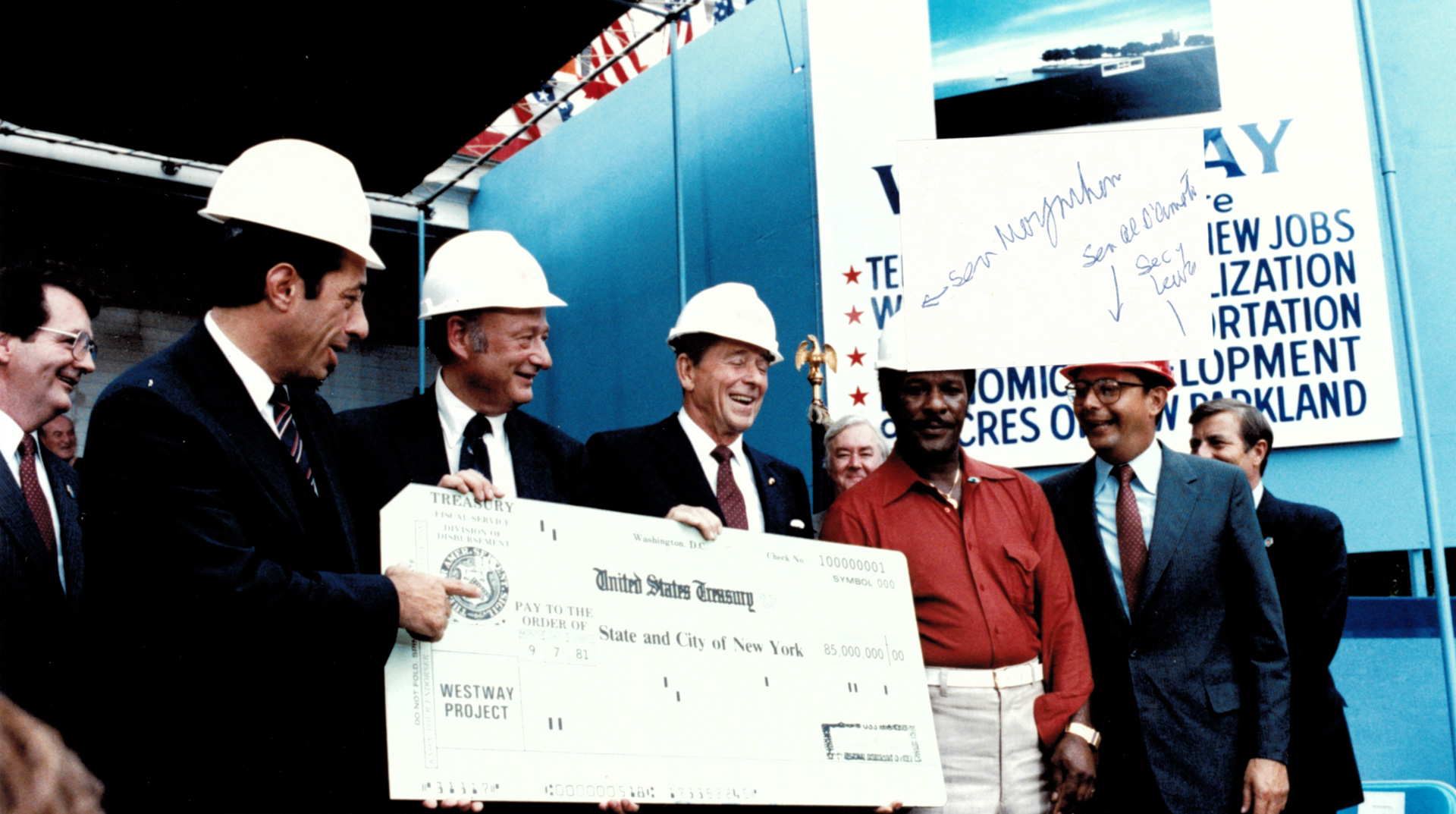
To develop Westway, Governor Nelson A. Rockefeller and Mayor John V. Lindsay selected Lowell K. Bridwell, who headed System Design Concepts of Columbia, Maryland, as executive director. Bridwell was a former Federal Highway Administrator (1967-1969) and would become Maryland's Secretary of Transportation (1981-1984). During his time as Westway's executive director, he returned to FHWA for a reunion on November 18, 1977, of former Federal Highway Administrators hosted by current Administrator William M. Cox. Left to right: Norbert T. Tiemann (1973-1977), John A. Volpe (Administrator (1956-1957) and Secretary of Transportation (1969-1973)), Mr. Cox (1977-1978), Secretary of Transportation Brock Adams (1977-1979), Francis C. "Frank" Turner (1969-1972), and Bridwell (1967-1969).
Revenge of the Striped Bass
One reason for President Reagan's optimism was that the key hurdle had been overcome in the few months since he took office in January. In February, the U.S. Army Corps of Engineers issued a permit for the dredging and filling to create the Westway landfill. In doing so, the Corps disregarded the concerns of Federal resources agencies, particularly regarding impacts to the striped bass habitat.
The Environmental Protection Agency (EPA) had authority to veto the permit. Despite concerns about adverse impacts on air quality and aquatic habitats, EPA's regional administrator decided not to veto the permit, largely on the theory that the anti-regulation Reagan Administration would overturn his veto. The Corps issued the permit on March 11, 1981. A Federal official, requesting anonymity, told The New York Times , "It's all over. The last Federal obstacle to Westway has fallen."
President Reagan, EPA, the Corps, and the anonymous Federal official had not taken Judge Thomas P. Griesa (pronounced grih-SAY) into account. Appointed by President Nixon, Griesa was a 51 year old resident of Manhattan.
Critics of Westway had combined their legal objections into a complaint to the U.S. District Court for the Southern District of New York in May 1981 focusing on air and funding issues. A second group of complainants, including the Sierra Club and NYC Clean Air Campaign (headed by Marcy Benstock, one of the most vocal Westway critics), named the Department of Transportation, the project, and the Corps as defendants, with the fishery objections as a focus.
After a 10-day trial in January 1982, Judge Griesa issued a 94-page decision on March 31. He dismissed many of the claims by the two groups, but he blocked construction of the landfill based on its threat to the striped bass habitat. The Corps' permit was invalid because of the Corps' "total failure" to prepare the required EIS to evaluate the "highly significant and productive habitat" for the bass. Instead, the Corps had "acquiesced in the urging of the New York State Department of Transportation [NYSDOT] and the Federal Highway Administration to withhold the information."
Governor Carey was pleased that Judge Griesa had rejected most of the complaints, but added, "It is deplorable - and ironic - that the first real snag for Westway is the result of a procedural error by a Federal agency."
On June 30, his follow-up decision stated that NYSDOT and FHWA had deliberately distorted information from a 1980 fish study and concealed essential facts. They "colluded in a successful effort to persuade the Corps of Engineers to refrain from issuing an environmental impact statement in connection with the landfill application." Some key witnesses during the January trial had "not disclosed the facts in a full and candid fashion." FHWA, "in collaboration with" NYSDOT, had "acted in willful derogation of the requirements of law in failing to issue a corrective supplemental environmental impact statement."
He singled out Bridwell, Westway's former executive director, for providing testimony that not only lacked plausibility but contained "a remarkable amount of inconsistency, evasion and asserted loss of memory on matters where memory would be expected." Judge Griesa accused Bridwell of withholding information, "a deliberate manipulation of facts," and awareness of the falsity of a key memorandum discounting the need for a supplemental EIS. Bridwell responded to reporters that, "In my opinion, I did what I was supposed to do and I did it properly."
On February 25, 1983, a unanimous U.S. Court of Appeals upheld Judge Griesa's decision that the Corps must prepare a supplemental EIS. The court found that "the record reflects distressing dereliction by the Federal agencies," although the decision noted that their actions were "not quite so unsavory" as Judge Griesa had described.
In September, Federal Highway Administrator Ray Barnhart expressed "sincere disappointment and complete frustration" because of the Corps' recent announcement that the supplemental EIS would take 2 years to prepare. He was "not prejudging," but was unwilling to approve FHWA's share of $37 million NYSDOT wanted to spend on design and demolition. "I have an aversion to continuing to spend money without regard to its ultimate productive value." On October 31, Judge Griesa took the decision out of Barnhart's hands by denying NYSDOT's request to spend the money.
At Governor Mario Cuomo's request, the Corps determined it could complete its study after only one winter instead of the 2 winters initially planned.
Secretary Bridwell
Secretary Lowell K. Bridwell was off to a good start since taking office in October 1981. The Baltimore Sun , calling him "The Mr. Fixit of Md. Roads," reported that he had "earned a reputation as a can-do administrator - paving roads, fixing potholes, installing stoplights, visiting city councils and trekking through snowstorms to inspect highways and bridges in need of repair." In contrast with his predecessor, he was "eager to stroke legislators who for years feuded openly with the state's transportation department." He also helped Governor Harry R. Hughes push a 4½-cent gas tax increase through the General Assembly in the election year of 1982.
Judge Griesa's criticism altered Secretary Bridwell's reputation. Although Governor Hughes continued to support him, Bridwell said, "Obviously it raised a cloud." At his request, Governor Hughes, a former Maryland Secretary of Transportation (1970-1977), appointed a three-member panel for "an independent inquiry."
The panel - State Attorney General Stephen H. Sachs, Anne Arundel County Senator John A. Cade, and State House Speaker Benjamin L. Cardin (today a United States Senator) - reported in February 1983 that Judge Griesa's broad and categorical denunciation of Bridwell was not supported by the evidence," but Bridwell "did not testify with complete forthrightness in significant respects" and his testimony "was marred by excessive advocacy." Neither "the tempestuous courtroom environment or his role as chief defender of the Westway project" relieved Bridwell of the responsibility "to testify under oath in a full and candid manner."
Governor Hughes rejected the panel's conclusions. His own review of the transcripts and reports did not "cause me to withdraw my confidence in him."
In New York, a 9-month study by the Temporary Commission of Investigation also criticized Bridwell. The report, released in June 1984, said his "primary concern at the trial was to be an effective advocate for Westway and not to present 'the whole truth' to the court."
Although Secretary Bridwell characterized the New York report as "simply not true," he conceded to reporters that he had been "an advocate for Westway, but that's what we were trying to do - get the project built."
By then, he had already announced he would leave office, as he would at the end of June, largely because of a public disagreement with Governor Hughes and the General Assembly over the transfer of $31 million a year from Maryland's Transportation Trust Fund to help balance the State's budget. One of his last actions was to designate the route of the 20-mile Intercounty Connector (MD 200) on June 27 linking I-95 and I-270 at an estimated cost of $216 million- a controversial project that experienced many starts and stops before the final segment of the toll road opened in November 2014 at a total cost of $2.56 billion.
Former Federal Highway Administrator and Maryland Secretary of Transportation Lowell Bridwell died on November 21, 1986 at the age of 62. He had recently undergone heart surgery. For the past year he had been director of the Transportation Studies Center at the University of Maryland. Governor Hughes described Secretary Bridwell as "an important figure in the creation" of the Department of Transportation and "an inspirational leader when he headed the department." He was a "creative, vibrant personality who made many unique contributions to Maryland."
An Impractical, Unfeasible Plan
In May 1984, the Corps released its study of the Westway landfill's impact on the striped bass population. The project would take up 19 percent of the Manhattan waterfront that constitutes the habitat of the bass during its winter migration. The landfill would have a "significant adverse impact" but techniques could be employed that "may be an effective management tool to help minimize impacts and enhance the resource." However, scientific, financial, and political factors "present formidable obstacles toward achieving its goals." The Corps held hearings on its study, but was not ready to act on the landfill permit until 1985.
In January 1985, EPA's regional administrator recommended that the Corps not approve a permit for the landfill. The Corps' study "leaves unanswered many crucial questions" about the impact on the striped bass habitat. The regional administrator recommended that the Corps refer the issue to the Council on Environmental Quality (CEQ) for help in resolving differences between the two agencies.
Nevertheless, on January 24, Colonel Fletcher H. Griffis, the Corps' district engineer, announced that the Corps would grant the permit. "I think that Westway's time has probably come. All great projects need a period of gestation. Westway had certainly gestated." He summarized the Corps' finding. "It is not in the public interest to deny the Westway permit based on the potentially minor impacts to the striped bass." A key factor was that "the character of the Hudson River estuary has changed, now that it is no longer necessary for commerce, the river can return to the public."
Mayor Koch, informed of the decision, said, "I am happy for the people of the City of New York. I am happy for the striped bass. I am happy for America."
On February 19, Administrator Lee M. Thomas withdrew EPA's opposition to Westway, did not veto the permit, and rejected the idea of appealing to CEQ. As Josephine S. Cooper, EPA's assistant for external affairs, put it, the 10 years study of the possible adverse environmental impacts of Westway was "too long." The appropriate course was "to allow Federal agency decision-making on Westway to come to final closure."
State officials estimated that dredging of the Hudson River could begin by summer to create 169 acres of land for parks, housing, and commercial and industrial development.
Senator Daniel Patrick Moynihan was pleased. "Westway has become a test of our ability to make decisions." On this occasion, EPA "passed that test." Senator Alfonse M. D'Amato was "ecstatic." As a practical matter, he said, "this decision will deal a crushing blow to those who seek to delay action through the courts."
Marcy Benstock of NYC Clean Air Campaign made clear that those would sought delay were not about to give up - they were headed back to the courts. "There is no time limit on an E.P.A. veto and we don't see how Congress can stand by and allow environmental laws to be subverted for such an astronomically expensive pork-barrel project."
The corps formally issued the permit on February 25 as critics went back to Judge Griesa to challenge the issuance.
Meanwhile, New Jersey officials, already engaged in commercial disputes with New York City, had taken notice of the striped bass. The Corps' study suggested that with part of the habitat taken away by the landfill, some of the striped bass would move to the New Jersey side of the Hudson River where they would complicate environmental permitting for commercial redevelopment.
As it happened, Representative James J. Howard of Monmouth County, New Jersey, was chairman of the House Committee on Public Works and Transportation. When a coalition introduced a bill to block FHWA from paying its 90-percent share of Westway, he said that Highway Trust Fund revenue is intended for highway construction. "The money should not be used for an impractical, unfeasible plan to give New York real-estate investors a change for additional profits through speculation." A spokesman said Senator Frank Lautenberg of New Jersey questioned the need for "an artificial gold coast grafted onto Manhattan's West Side, using the highway as an excuse for a real-estate project."
Judge Griesa held a trial on the permit from May 20 through July 22. On August 8, he made permanent the 3-year old injunction he had issued on landfill construction, saying the Corps' action was improper and its testimony doubtful. The study had been inadequate, he said, having been cut back from two winters to one. In May 1984, the Corps' study had referred to "a significant adverse impact," but the Corps now says it always meant the impacts were minor. Judge Griesa referred to this position as "incredible" and called the Corps' position "altogether bizarre" and "sheer fiction."
A Bad September for Westway
Federal and State agencies appealed the decision to the U.S. Court of Appeals for the Second Circuit. On September 12, a three-judge panel of the Appeals Court upheld Judge Griesa's decision. The panel agreed with Judge Griesa's finding that in changing "significant" to mean "measurable but minor," the Corps was engaging in "Orwellian-like -doublespeak . . . .-"
By coincidence, the House voted on the same day on an anti-Westway amendment to the Department of Transportation and Related Agencies appropriations act, 1986. The amendment would block payment of the salary of any Federal officials who approved construction of the landfill. After an hour-long debate, the House adopted the amendment by a vote of 287 to 132. (The provision would be included in the law, P.L. 99-120, under "Federal Highway Administration - Limitation on General Operating Expenses.")
The ability to use the withdrawal-substitution provision was to end on September 30. Senators Moynihan and D'Amato did not see any prospect of securing approval of legislation to extend the deadline by then. Senator Robert T. Stafford, chairman of the Committee on Environment and Public Works, said he did not have time to act. His counterpart in the House, Chairman Howard, declared, "Westway is dead. Congress won't let them build Westway." Mayor Koch admitted, "I believe that you can hear the death rattle" of Westway.
On September 19, Governor Cuomo and Mayor Koch announced that after "more than 12 years of effort to begin construction of Westway, we have reached an impasse." Facing court and congressional opposition, "we have agreed to trade in our rights to Westway for alternative funding." This decision was "by no means a happy one," but it was "a prudent one under all the circumstances." In the end, Westway was "finally defeated because of a mistake by the Army Corps of Engineers that led to adverse court decisions and by unfavorable actions by the United States Congress." However, they did not want to "spend time dwelling upon our regret." Instead they were working on the substitution package.
In a ceremony at 3 p.m., on September 30, 1985, 9 hours before the deadline, Secretary of Transportation Elizabeth Hanford Dole signed letters to Governor Cuomo and Mayor Koch. She informed them that, "We have determined that I-478 is not essential to completion of a unified and connected Interstate System." She, therefore, approved withdrawal "of the northerly 4.26-mile segment of I-478" and "all the substitute project concepts listed in the concept program." (She also withdrew I-495 west of I-478 on the east side of Manhattan because without I-478, it was no longer connected to the Interstate System.)
Based on the 1983 Interstate Cost Estimate for the two Interstate routes, as adjusted for changes in construction costs, she informed them that the amount of Federal funds authorized for substitute projects was $1.725 billion. It was the largest trade-in during the life of the Interstate withdrawal-substitution program initiated by the 1973 Act. Governor Cuomo and Mayor Koch had agreed to split the substitution funds between mass transit (60 percent) and highways (40 percent), including a replacement for the West Side Highway. Secretary Dole emphasized that the substitution projects would have to go through the normal development process before a commitment of Federal substitution funds would be possible.
After signing the letters, Secretary Dole handed pens - white with Secretary Dole's signature in blue - to Senators Moynihan and D'Amato, both strong supporters of Westway. Tucking the pen into his coat, Senator Moynihan told reporters, "I don't know why they thought this was an occasion for giving out pens."
The Times concluded, "The announcement today ended years of environmental battles, political reversals, grand dreams and painful frustration." Senator Moynihan put it this way: "It says something about us that we can't do these things anymore."
A Moment in Time Passes
Construction of the replacement for the West Side Highway - nicknamed "Lessway" - began in 1996 and was completed in August 2001. In a ceremony on April 25, 1999, Mayor Rudolph W. Giuliani and George Steinbrenner, owner of the New York Yankees, took part in a ceremony naming the new road the "Joe DiMaggio Highway" in honor of one of the greatest players in Yankees and baseball history.
As for the striped bass, a 2016 Times article stated that, "With the jutting jaw of a mob kingpin and the pinstripes of a Wall Street executive, striped bass swim through the brackish waters of New York Harbor like old-school New Yorkers - as if they own the place." Their population has increased because of such factors as a reduction of fishing pressure, improved water quality and, of course, Judge Griesa. The reduction in fishing pressure may be due to cautions related to PCB contamination from industrial chemicals in the Hudson River. People may eat striped bass and other fish and crabs from the river but they should be avoided by women of childbearing age and children under 16 years old. Others may eat the fish and crabs, but with a limit of one meal of striped bass a month.
Judge Griesa died on December 24, 2017. Although he had accomplished many things in his life, his death was noted in a lengthy Times obituary under the headline: "Judge Thomas P. Griesa, Who Ruled Against Westway, Dies at 87."
When President Reagan went to New York City in September 1981 to announce that "The Westway project begins today," his moment in time turned out to be the high point in the history of a project that came to an end 4 years later.
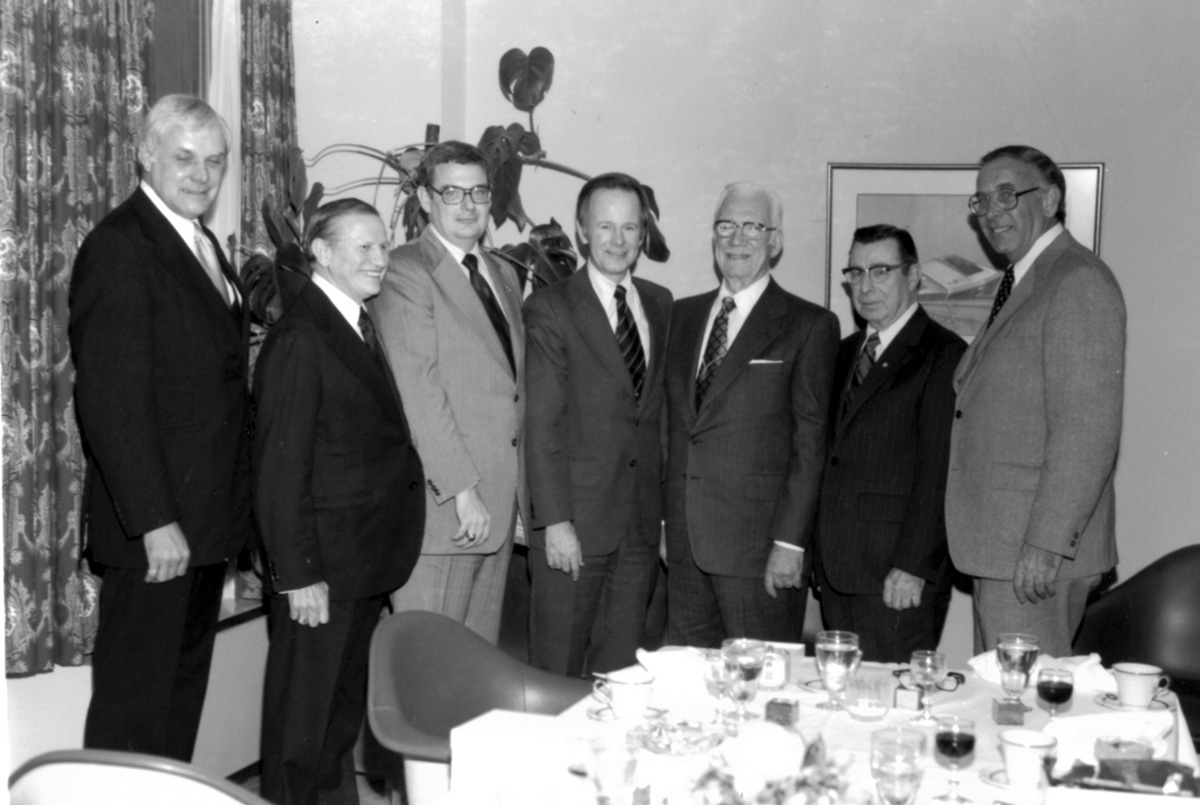
On September 17, 1963, President John F. Kennedy met in the White House to discuss the routing of I-24 with the Governors from the four affected States. Left to right: Governor John Dalton (Missouri), Governor Frank Clement (Tennessee), Secretary of Commerce Luther Hodges, President Kennedy, Governor Otto Kerner (Illinois), Governor Bert Combs (Kentucky), and Federal Highway Administrator Rex M. Whitton. (Photo courtesy John F. Kennedy Library)
Sources: In addition to contemporary articles from The New York Times , The Baltimore Sun , and other news reports, I consulted William W. Buzbee's Fighting Westway: Environmental Law, Citizen Activism, and the Regulatory War That Transformed New York City (Cornell University Press, 2014) and The Westway Project: A Study of Failure in Federal/State Relations (Committee on Government Operations, U.S. House of Representatives, 98th Congress, 2d Session, House Report 98-1166, November 1, 1984)

